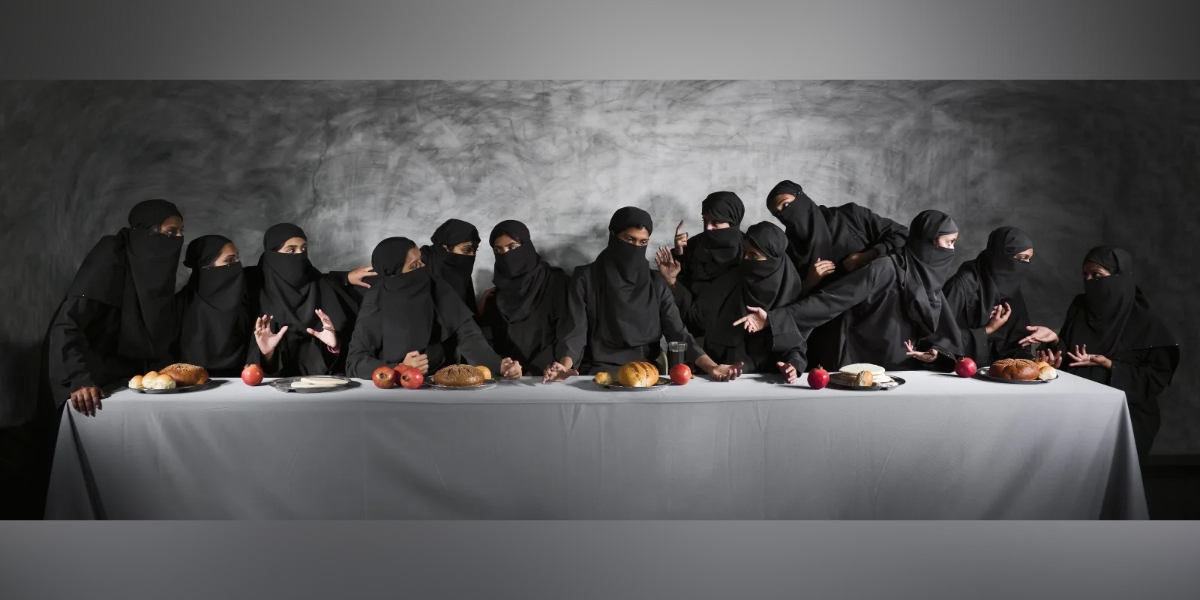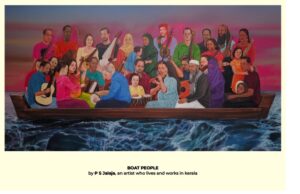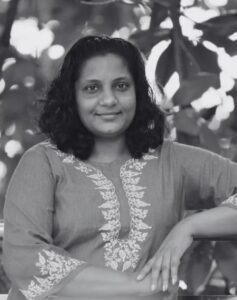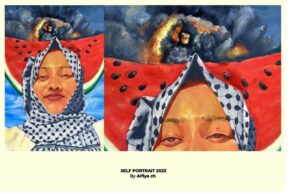The show is a small but powerful act of solidarity with Gaza and Palestine. Every postcard, brushstroke, and piece of concrete becomes part of a shared memory, a quiet form of resistance.
Published Oct 25, 2025 | 8:00 AM ⚊ Updated Oct 27, 2025 | 9:44 PM

Last supper Gaza. (Vivek Vilasini)
Synopsis: Kerala-based artist PS Jalaja’s exhibition, Museum of Debt, is a small but powerful act of solidarity with Gaza and Palestine. Every postcard, brushstroke, and piece of concrete becomes part of a shared memory, a quiet form of resistance.
When a land is destroyed, when people lose their homes and roots, when even children’s coffins are sold the most, and when genocide takes place, how can an artist stay silent? Especially one who believes that art must protest injustice and serve people.
In a time when wars are broadcast live and people grow numb to suffering, Kerala-based artist PS Jalaja chooses to slow down, to truly witness. Her new exhibition, Museum of Debt, is not just a place to see art but a space to remember.
The show is a small but powerful act of solidarity with Gaza and Palestine. Every postcard, brushstroke, and piece of concrete becomes part of a shared memory, a quiet form of resistance.
Here, ”Debt” does not mean money.
It is a moral and human debt, what we owe to those whose lives have been destroyed, to those erased from history, and to the act of remembering itself. Museum of Debt is Jalaja’s way of saying that art can bear witness, that remembering is itself a form of protest, and this exhibition is one of its kind in India.

Boat People by Jalaja PS
At the heart of the Museum of Debt lies a simple yet profound metaphor — the postcard.
The exhibition gathers selected artworks from diverse artists, each translated into the intimate scale of postcards. “Using postcards in visual art is not new. Postcards are always personal; they carry emotions close to the heart. To maintain that personalised feel, it felt apt.” Jalaja told South First.
A postcard, small enough to fit into a hand yet vast enough to carry the weight of memory, becomes Jalaja’s chosen vessel of remembrance. It embodies both distance and closeness — a message sent across borders, a voice whispering through rubble. Through this modest format, art travels not as a commodity, but as communication, as empathy materialised.
These postcards are displayed within a miniature library shelf made of concrete — a deliberate choice of material and form. Concrete, as Jalaja describes, “is a material of both construction and destruction.”
It reminds us of the destroyed homes in Gaza, but also represents strength and survival. The shelf looks like something from a library, a place that keeps memories safe and shows quiet resistance. Together, they become what Jalaja calls “an archive of solidarity”, something both fragile and powerful, personal and large in meaning.
The Museum of Debt is, therefore, not a finished museum. It is a living shelf of fragments, a growing architecture of memory that refuses closure. It does not attempt to repay what is irreparable; it insists on acknowledgement, on bearing witness, and on creating a space where grief, resilience, and solidarity coexist.
Parallel to Museum of Debt, Jalaja’s ongoing series, The War Face of Truth, extends her artistic activism beyond gallery walls. It is a live painting series unfolding across all 14 districts of Kerala, within solidarity gatherings for Gaza and Palestine.
“At a time when images of war flood our screens, I feel compelled to create not from a place of distance, but proximity,” Jalaja wrote in her concept note.
Through these large-scale live works, she transforms public spaces into sites of witnessing. Each canvas emerges amidst the hum of people, speeches, and shared sorrow, a living performance of resistance. Her work confronts the brutality of war and the silent complicity of power.
“My paintings are not meant to be representations. They are acts of witness.” Each brushstroke becomes a confrontation, each colour a cry against erasure. In these gatherings, art is not consumed; it participates.
By choosing streets over studios, Jalaja collapses the distance between art and activism.
“Visual art needs to reach more people. The audience in Kerala is willing to receive, but not many artists come out of their studios and engage with public issues. Artists should be there in protests, and their art has to speak — then only people will connect.”
Her conviction redefines the artist’s role — not as a distant observer, but as a participant, an accomplice in truth-telling. The War Face of Truth is both art and act; a protest that paints, and a painting that protests.

Visual artist PS Jalaja.
For PS Jalaja, art has always been a conversation with history — personal, political, and collective. Her practice delves into the complexities of the male figure, exploring its contradictions as both conqueror and defeated. Drawing inspiration from daily life, she interprets human behaviour through a lens that refuses simplification.
Her men are at once heroic and vulnerable, embodying the paradoxes of power and fragility.
In her words, her canvases are “spaces where laughter and sorrow coexist”. They reflect not only external conflicts but internal ones — the wars of the self, the fractures of conscience. Jalaja’s visual language is deeply human; it does not shout but insists on being heard.
Residing and working in Kerala, she continues to challenge the notion of art as separate from lived experience. Her shift toward projects like Museum of Debt and The War Face of Truth marks a powerful evolution, an artist stepping fully into the public, using her art as both a mirror and a megaphone.
Her work is not about providing answers but about posing the questions we collectively avoid: What does it mean to bear witness? What is our debt to memory? How do we stand in solidarity from afar?

Self Portrait by Alfiya CH.
Museum of Debt is not a conventional exhibition; it is a gesture of responsibility. It invites viewers to confront what is owed, not in currency, but in conscience. It reminds us that remembrance is not passive; it is an act of care, of resistance.
By translating grief into postcards and resistance into paint, Jalaja builds a bridge between Kerala and Gaza, between art and activism, between memory and action. Her museum is unfinished by design, because so is justice, so is healing.
In the quiet weight of concrete and the fragile intimacy of a postcard, Jalaja’s work teaches us what it means to remember together — to hold space for pain without looking away.
The Museum of Debt does not seek to repay the unpayable; it seeks to keep remembering, to keep standing, and to keep creating in the face of destruction.
And the most powerful part is that, a woman artist travelling across Kerala, carrying in her heart the pain of Gaza — a land torn apart, where lives and dreams have been shattered. Her journey is not for fame or galleries, but to connect emotions, to speak for those silenced by war.
Through her art, she turns grief into resistance; each brushstroke becomes an act of solidarity, a quiet protest. Because sometimes, colours and lines on a canvas can cut deeper than any weapon in the world.
(Edited by Muhammed Fazil.)
